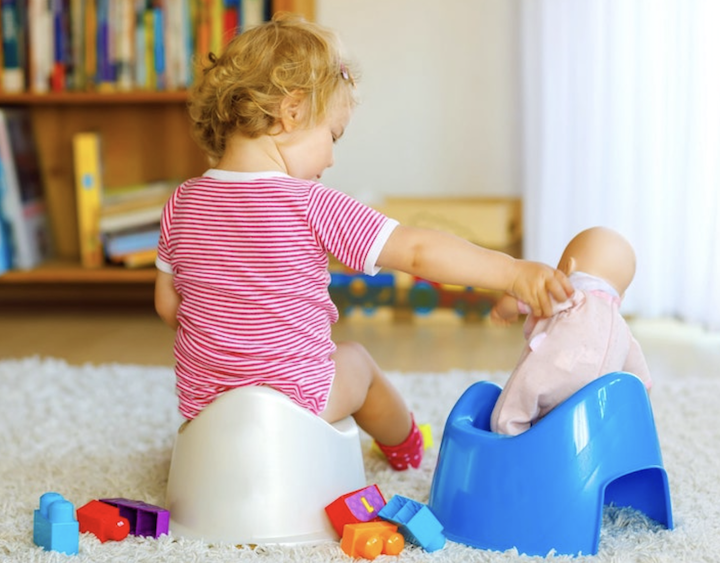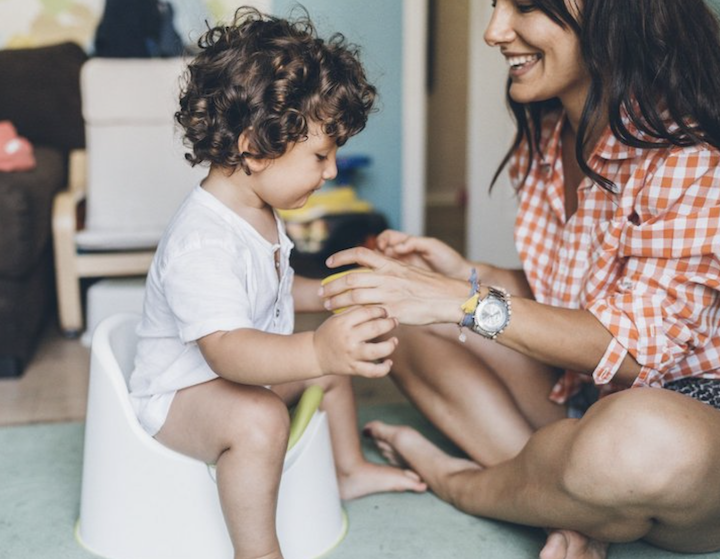
 Post Category - ParentingParenting - Post Category - Toddler & PreschoolerToddler & Preschooler
Post Category - ParentingParenting - Post Category - Toddler & PreschoolerToddler & PreschoolerIt’s the ultimate in the parenting Olympics: potty training. Are you up for the challenge, mamas and dads? Most importantly, is your child ready? Here’s how to ditch the diapers and get your kids potty trained with minimal stress!
Ready to swap out the diapers for pants? Potty training can lead to greater independence for your child, allow them to meet basic requirements for school entry, give your family more freedom and less travel hassle, and of course, is more environmentally friendly! First and foremost, we suggest waiting until your child is ready to toilet train (see a list of potty training readiness signs below). If you force it, you’ll both get stressed and frustrated, and in extreme cases it can cause physiological harm to your child. It’s also important to make sure your whole family is prepared for the transition from nappies to the potty; the information below can help you decide the best potty training approach to take…
7 Signs your child is ready to go from diapers to the potty
- Your child should be at least 2 years old.
- Your child should have periods of the day (a couple of hours) when they are dry.
- Your little one should be familiar with toileting language such as ‘potty’, ‘toilet’, ‘underpants‘, etc. The words you choose should be specific to your family, used consistently, and words you are comfortable saying in public.
- They should be capable of pulling up and down their pants independently or with minimal assistance (depending on the clothing attire).
- Your child is able to follow simple one-step instructions without difficulty, such as “Come here” and “Sit down”.
- Your child should show awareness of the need to use the toilet after they have soiled their nappy. For instance, a child may point to their nappy, ask to be changed or take your hand and lead you to the changing area.
- Your little one should understand the concept of what the toilet is used for. You can teach this by modelling or reading books about going to the toilet. If your child seems to have difficulty with any of these skills, talk to your paediatrician before beginning toilet training.
Read More: Everything To Know about Cloth Diapers: One Mama’s Experience & Tips
Is your family ready for the potty training to start?
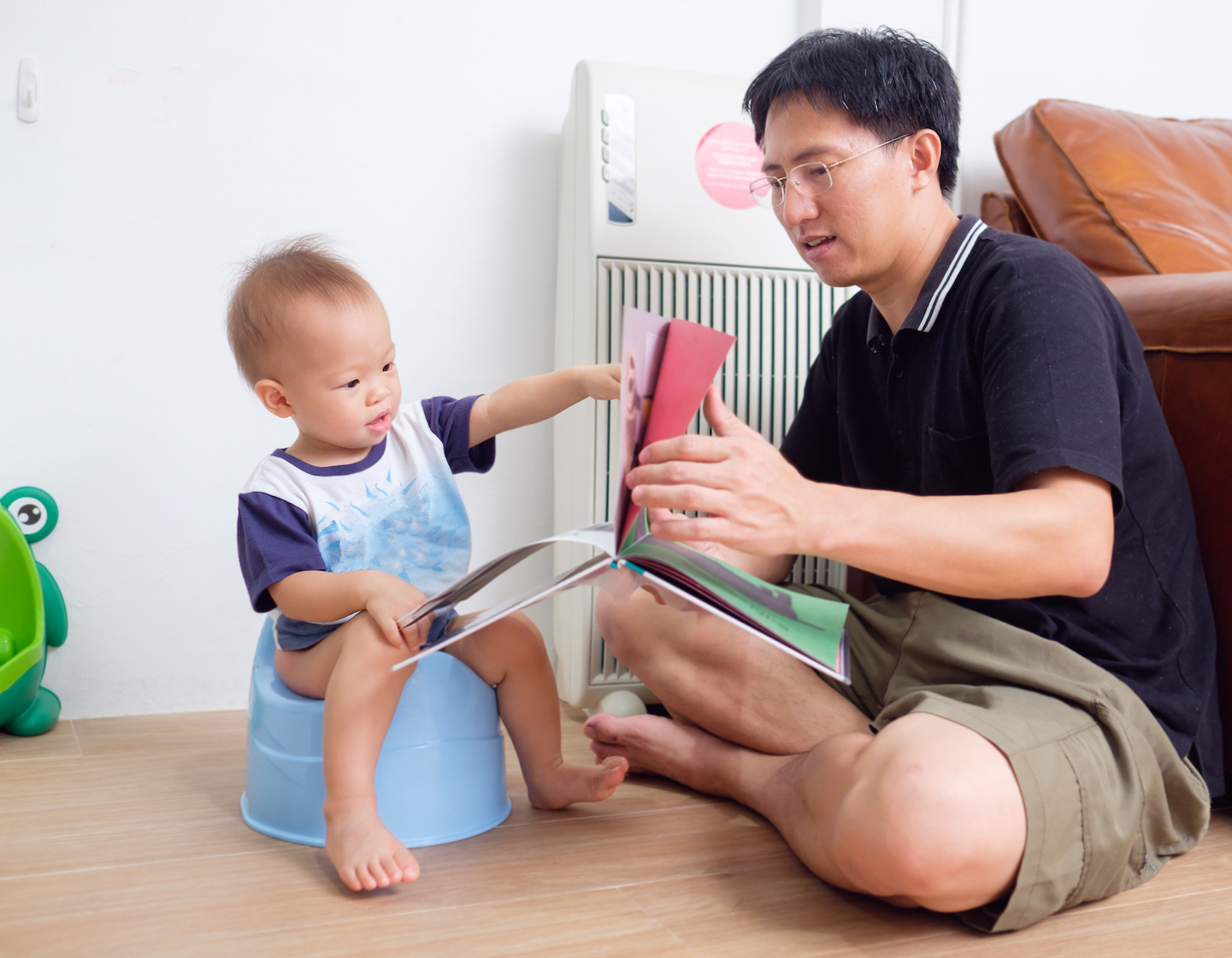
Make sure there are no stressful events taking place or coming up in the near future (e.g. moving, change in caretakers). Ensure everyone in the home (including domestic helpers, nannies and grandparents) fully understands the potty training plan and what to do when accidents inevitably happen. Remember, accidents are normal and part of the training process.
Ensure you are ready to commit to this change and will have the time to be consistent and patient with your child (i.e. if the idea of being given 30 seconds’ notice to find a toilet before an accident happens stresses you out, maybe wait a bit!).
Potty training seat
Purchase a potty training seat or toilet seat adapter so your child’s feet touch the floor for support. We are fans of this potty training seat from IKEA, and at $16.90 it’s hard to argue with the price!
Potty training sticker charts
Have a potty training sticker chart or some kind of reward system developed. This can include a variety of preferred toys, stickers, snacks, games and special one-on-one time with a parent. Potty training sticker charts (available from Amazon Sg) are a great way to track goals and help remind parents to reward progress.
Read More: Our Five Favourite Potty Training Apps
Pick out some big boy/girl pants
It is important to toilet train children in big kid pants. Having your child pick out their own new underpants can make this process more fun and something to look forward to.
Which potty training method to use?
Toilet training: slow method
1. Take your child to the bathroom with you so they can learn from an expert how it is done.
2. Have your child practice sitting on the potty when you first purchase the potty training seat. This can be done as “pretend practice” with their clothes on. Praise your child and show excitement when they sit on the potty. Now, it’s time to ditch the nappies!
3. Next, have your child sit regularly on the potty throughout the day (without their clothes/diaper on) so there are lots of chances for them to use it properly. Ask your child routinely if they need to “go potty”. Remember to have your child sit, even if they say they don’t need to “go potty”. Sometimes children don’t recognise the urge to pee or poop until they are relaxed and not distracted by other things (e.g., playing or watching T.V.).
4. Make sure to give your child lots of praise each time they urinate or poop in the potty. You can use larger rewards from the potty sticker reward chart as well.
Potty training: intense method
If regular toilet training per above is not successful, you can try a more intensive potty training method such as the weekend fast track. Some children may require intensive toilet training for a number of reasons (e.g. family convenience, urgency due to school entrance deadlines, etc.). This type of potty training typically takes place over a weekend when a family can devote their time and energy to the procedure at home. For this process, it is helpful to keep kids “pants free” (underpants and a shirt only) at home for the day.
1. The first step of this potty training method is again, to ditch the nappies!
2. The next step is to increase fluids by giving your child at least one cup of liquid every hour. Consider varying the beverage so your child will continue to drink.
3. Next, start off reminding your child to use the potty every 15 minutes and take them for a sit. This will help your child learn to self-initiate and recognise when they need to go. As your child learns to request the potty and urinate with more independence, you can spread out the time between sits/reminders (15, 30, 45, 60 minutes).
4. Complete pant checks (dry pants vs. wet pants) at the same time you give the reminder. If your child is dry, praise him/her for this accomplishment (“Great job, you still have dry pants!”) but if they are wet, follow through with the toilet sit and then clean up the accident.
5. Don’t have lengthy discussions about the accident, just move on. Instead, focus on giving your attention to the positive accomplishments.
6. Each time they sit on the toilet, praise your child for listening. Remember, this is not necessarily fun for them either! Provide a small reward or time with a preferred special toy each time he/she urinates or has a poop in the potty. When your child self-initiates and uses the toilet, make a big deal out of it. This is cause for celebration! Have something special planned for when this happens (special play time with a parent, new toy, colouring book or stickers).
7. Complete this process over the entire weekend. By the end of the weekend (Sunday afternoon) you should be providing reminders and having toilet sits every 1-2 hours depending on when your child is consuming more fluids.
Urine alarm for night potty training
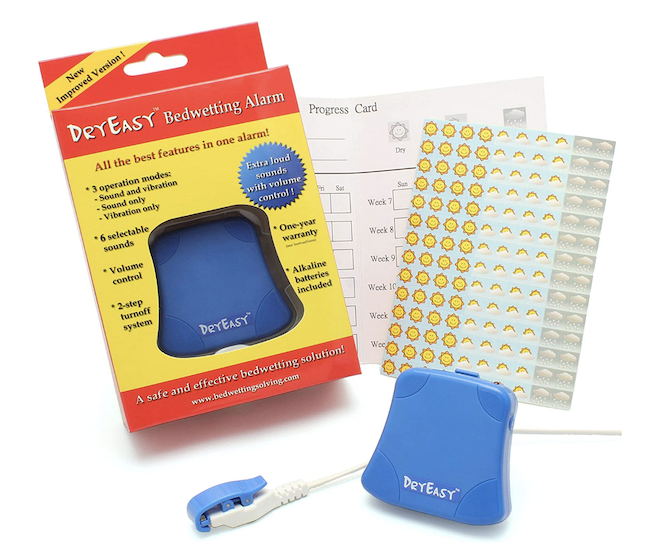
A urine alarm is a device that is attached to your child’s underpants and buzzes when moist. We have had huge success with DRYEASY Bedwetting Alarm which has been passed to many friends to borrow (after a wash!). Typically the sound/vibration of the buzzer will cause the child to immediately stop urinating temporarily so you can get him/her to the bathroom. This allows your child to have more successful sits on the potty and for you to know if an accident occurs. The device can be used as part of the toilet training process. We have had particular success with using a urine device for bedwetting at night once your child is potty trained in the day (but for this you may need to bunk in with your child for up to 2 weeks to ensure the night potty training is complete). The general idea is that the alarm needs to wake the child up and THEY need to be in charge of stopping the alarm (this ensures they are fully awake), taking themself to the bathroom (you can be on hand to help but the process needs to be independent) finishing on the toilet (even if they don’t need to go any more) and then you can help give them a quick change of pants.
For night potty training we recommend setting the bed up with multiple waterproof sheets and covers – one waterproof sheet (from IKEA) then one bedsheet and then on top you put another waterproof sheet and finish with a bed sheet. The idea is that in the middle of the night it is quick to remove the two wet sheets and you have the bed already made underneath!
General tips for potty training
- Remember how much your child values your attention! When your child urinates in the potty, congratulate them by providing lots of praise (Attaboys, high fives, hugs!). Give them something special immediately after they use the potty successfully rather than later in the day.
- Expect accidents. If your child has an accident, do not scold, shame or punish them. Simply say, “No wet pants” in a neutral tone, take them to the potty, and have them sit for about one minute. If they finish urinating in the toilet, praise them! If they are unable to go, it is OK. Clean them up and go back to your daily routine. There will be plenty of chances to try again.
- Complete pant checks throughout the day. If your child is dry praise them for learning to control their bladder/bowels by telling them, “Nice job, you have dry pants!”
- Take them to the toilet frequently throughout the day so they have more opportunities to go in the potty and fewer chances of having accidents.
- Stay calm and be patient. Learning any new skill takes time, practice and positive feedback.
- Keep the nappies on at night. Children take longer to be consistently dry at night vs during the day. If you are not seeing progress, or your child experiences unusual or unexpected reactions, stop the potty training and contact a professional (physician, pediatric psychologist). Most often the complication can be easily addressed and your family can be back on track in no time!
More Potty training Resources:
Toilet Training in Less than a Day
Elmo’s Potty Time
Daniel Tiger’s Neighborhood: Prince Wednesday Goes to the Potty / Daniel Goes to the Potty
Counterpoint: Janet Lansbury: “3 Reasons Kids Don’t Need Toilet Training (and What to Do Instead)”
All About Elimination Communication






 View All
View All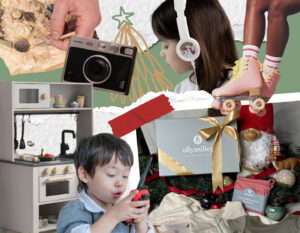





 View All
View All



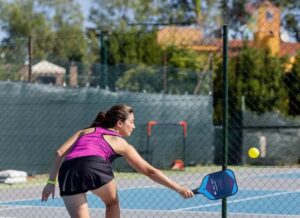




 View All
View All



